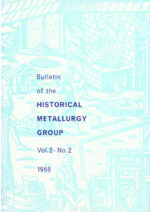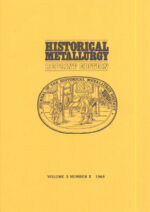Journal Contents
Pioneering in steelmaldng at the Collins Axe Company: 1826-1924
Robert Gordon and Geoffrey Tweedale
Pages 1-11
“Ingenious Yankees” made great strides in establishing mature manufacturing industries in the United States’ in the first two thirds of the 19th century, but had much less success in maldng the iron and, especially, the steel used in their machinery and manufactured products. They remained almost totally dependent on imports from Sheffield, England, until after the Civil War, particularly for high-quality steel stock and for some types of tools made of steel, such as files and saws. It was thus one of the ironies of early 19th century American industrialization that a number of the country’s most successful industries — such as the manufacture of woodworking tools — relied upon English steel. Some of the reasons for this dependence on foreign supphers and some of the factors that eventually led to independence, can be found in the history of the Collins Co., the celebrated makers of edge tools in Collinsville, Connecticut.
The Collins Co. was founded in 1826 by the brothers David and Samuel Collins and their cousin William Wells with the idea of specializing in the factory production of axes, which before that time had been made by individual blacksmiths. They acquired a water privilege formerly occupied by a grist mill and by 1828 had built a trip hammer shop with an undershot wheel for every hammer that allowed each workman to make about eight axes per day. Changes in the production process began to be made as soon as the business was estabhshed and through the next forty years the company was an important centre for innovation in two major components of American manufacturing technology. New methods of forming and shaping metal developed by E K Root and several other inventors employed at Collinsville were subsequently adopted at Colt’s armoury and, subsequently, in other industries. The methods of using water power resources pioneered by the company allowed the works to operate entirely on power supplied by the Farmington River until the business was closed in 1967.
Lamination technique in iron artifacts in ancient India
O P Agrawal, Hari Narain, Jai Prakesh and S K Bhatia
Pages 12-26
The development of lamination technique in iron artifacts in ancient India is described. This technique imparts internal as well as external strength to the weapons and tools. Results of metallographic studies of iron artifacts from various excavation sites in India are given. The results show that the lamination technique was in vogue in India during 1200 BC-600 AD.
The occurrence of Iscorite' in Medieval iron slags
D Rose, G Endlicher and A Mucke
Pages 27-33
The occurence of “iscorite” in medieval iron slags was proved by paragenetic observations and by micrdprobe analyses. The chemical composition of this rare phase is discussed under consideration of the other compounds (wustite, fayalite, magnetite, glass) of the paragenesis. According to the investigations, “iscorite” is stable only in a narrow field concerning temperature and oxygen fugacity.
Oxidation enrichment bands in wrought iron
R F Tylecote
Pages 33-39
When a smith heats a piece of wrought iron in his hearth prior to forging, the conditions are such that the surface of the iron oxidises very rapidly producing the well-known hammer scale. This exfoliates when struck by the hammer due to its brittleness and the difference between the coefficient of expansion of the metal and that of the scale.
The scale formed in the range 1000-1200°C consists mainly of wustite (‘FeO’) with a small amount of magnetite and hematite on top. The slag present in the wrought iron melts and tends to form an intergranular film. The iron in the metal oxidises more rapidly than some of the impurities that it contains such as nickel, arsenic, copper and antimony. These elements are therefore enriched in the metal adjacent to the scale and do not have the time to diffuse back into the metal matrix as their diffusion rates are relatively slow even at 1200°C. They may form intergranular layers in the metal leading to embrittlement on forging, discrete particles or layers of enrichment.
Elements that oxidise more readily than iron such as manganese form enriched layers in the scale. In the case of phosphorus the exact mechanism has still to be determined; there are indications that it forms an enriched layer like arsenic.
Early iron ore production from the Forest of Dean and district
David Bick
Pages 39-
Much has been written on the iron mines and ironworks of Dean and district, but due to lack of records the early output of this ancient industry is very difficiilt to assess.
One method currently in hand is to measure the volume of open-cast excavations or Scowles, which in spite of centuries of random in-filling, are still visible in many parts of Dean and even beyond its borders. Making certain assumptions these volumes can be translated into ore and over 1,000,000 tons have been estimated from surface workings in Noxon Park and Wigpool areas.’ However, the figures are difficult to equate with any definite time-span.
Another approach is to assess the ore from the quantities of bloomery slag or cinders which accumulated over 2,000 years from the Iron Age up to the introduction of the charcoal blast-furnace near the end of the 16th century. This paper sets out to explain and illustrate the method, which can be refined in various ways.






There are no reviews yet.